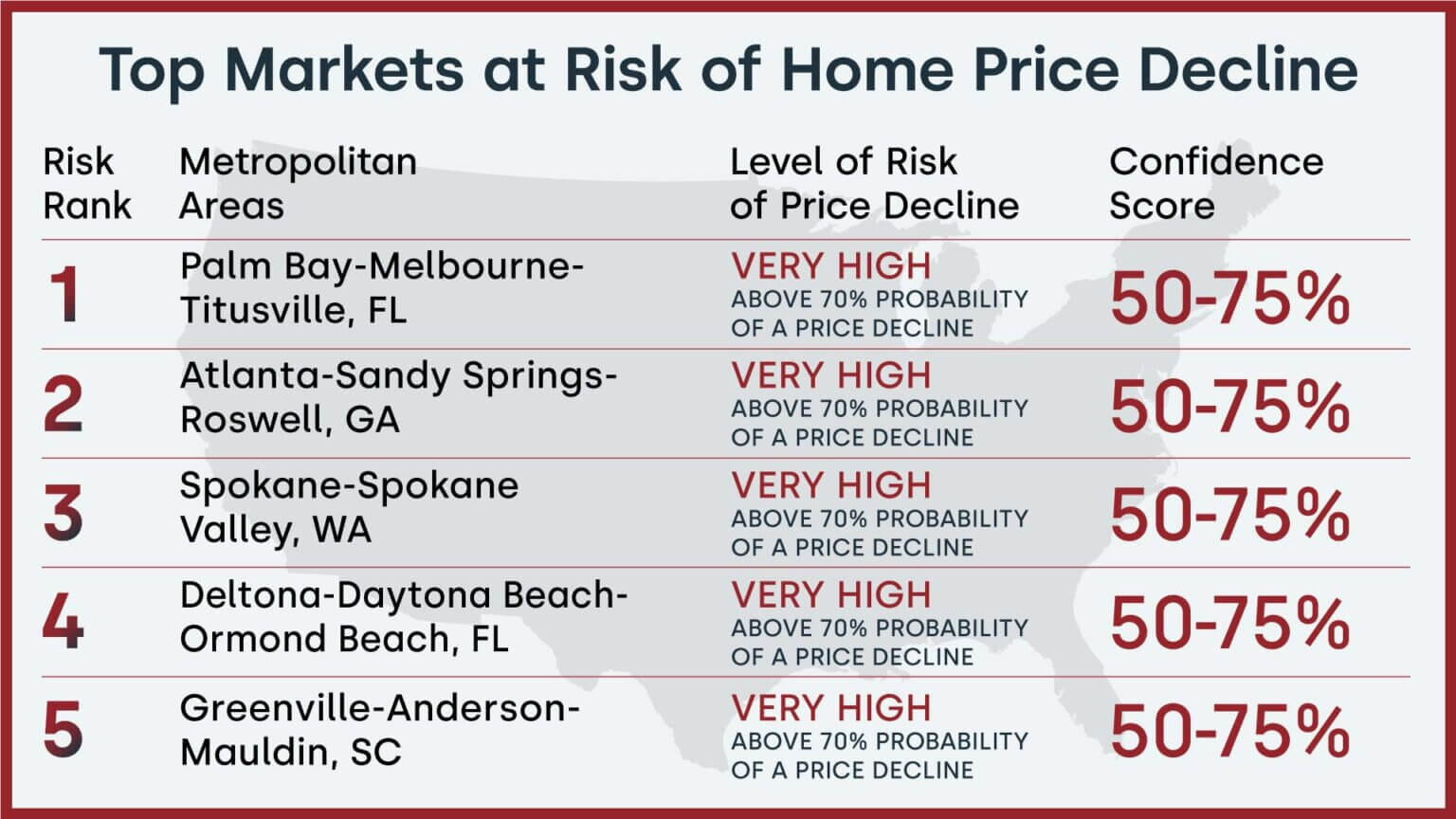The U.S. housing market continues to see steady growth, with national year-over-year gains remaining above 5%. However, a closer look reveals a trend shift. While the Northeast thrives with robust price increases, some housing markets across the country are showing signs of potential cooling.
This article dives into the latest data from CoreLogic’s Market Risk Indicator (MRI) to explore the top five U.S. markets facing a very high risk of price declines in the next 12 months:
5 Housing Markets Facing Potential Price Slowdown
- Palm Bay-Melbourne-Titusville, Florida: This Florida corridor tops the list with a 70% or higher probability of experiencing a price dip.
- Atlanta-Sandy Springs-Roswell, Georgia: The Atlanta metro area, a popular relocation destination, finds itself at risk of a price decline.
- Spokane-Spokane Valley, Washington: This Washington market, another migration magnet, joins the list of potentially softening prices.
- Deltona-Daytona Beach-Ormond Beach, Florida: Another Florida entry, the Deltona-Daytona Beach area, faces a similar risk of price decline.
- Greenville-Anderson-Mauldin, South Carolina: This South Carolina market, a recent growth engine, rounds out the top five with a high risk of price slowdown.
Why the Slowdown?
While the national market enjoys steady growth, several factors contribute to the potential price cooling in these specific locations.
- Inventory Levels: Unlike the Northeast, where tight inventory continues to fuel price hikes, some of the at-risk markets, particularly those in Florida, might be experiencing a catch-up in for-sale listings. This rise in available homes could ease the intense competition that previously drove prices upwards.
- Affordability Concerns: Nationally, rising mortgage rates and overall housing costs are putting a strain on affordability. This trend might be particularly impactful in these potentially slowing markets, dampening buyer demand and potentially leading to price adjustments.
Moreover, the slow rise in sales compared to previous years is evident, reflecting the overall supply-and-demand mismatch. Rising mortgage rates and the persistent affordability crunch deter prospective buyers, further restraining home sales and influencing market dynamics.


Regional Disparities
The housing market’s regional trends reflect disparities across different parts of the country. Northeastern states continue to lead in annual home price growth, driven by factors such as migration to bedroom communities of major cities, higher household incomes, and limited inventory gains compared to other regions.
On the other hand, states like Idaho, Washington, and Utah are furthest from their price peaks, as some Americans migrated to escape the pandemic’s impact. These states present contrasting scenarios, with sluggish price recovery compared to regions experiencing robust growth.
Expert Insights
According to Dr. Selma Hepp, chief economist for CoreLogic, the surge in the cost of homeownership, compounded by rising insurance and tax expenses, contributes to the challenges facing potential homebuyers. Despite a long-anticipated break in for-sale inventory, the affordability crunch persists, hampering sales and reflecting the broader supply-and-demand mismatch in the housing market.
National Market Forecast
Looking ahead, the CoreLogic HPI Forecast indicates a modest rise in home prices nationally, with a projected increase of 0.8% from March 2024 to April 2024. On a year-over-year basis, home prices are expected to rise by 3.7% from March 2024 to March 2025. These forecasts provide valuable insights for stakeholders navigating the dynamic landscape of the U.S. housing market.
The Takeaway: The U.S. housing market is experiencing a period of regional differentiation. While some areas might see price adjustments, the national outlook remains optimistic. For potential homebuyers in these at-risk markets, staying informed about local trends and exercising patience could lead to more favorable buying opportunities.



